This article is published with the authorization of “Post and Telecommunications Design Technology”.
If you need to reprint, please contact “Post and Telecommunications Design Technology” for authorization.
Follow the WeChat public account of Post and Telecommunications Design Technology: ydsjjs, welcome to follow!
Abstract:The construction scale of NB-IoT has become increasingly complete. The municipal electric vehicle management project involves installing management terminals on electric vehicles to utilize the NB-IoT network to upload the current location information of electric vehicles in real-time, enabling the display of the current position and movement trajectory of electric vehicles on the application platform, along with related management functions, assisting the police in preventing electric vehicle theft and comprehensive traffic management.1IntroductionTo fully implement the deployment of the State Council and further enhance urban management levels, in 2018, the municipal government launched a comprehensive safety management initiative for electric bicycles throughout the city. The municipal public security bureau, as the project demand unit, determined the technical solution of NB-IoT + GPS/Beidou. The operator provides the NB-IoT network environment and IoT cards, while manufacturers supply chips, modules, and service platforms to jointly build a testing environment. An integrated network support working group was actively established to develop detailed implementation plans for various aspects such as NB network upgrades, network parameter optimization, external interference troubleshooting, module and network parameter matching, and module issue localization and resolution, effectively ensuring network coverage and service application in the project testing area, and successfully assisting the public security bureau in completing user access in the pilot area, electric vehicle theft prevention, and comprehensive traffic management.We selected Dengfeng City as the pilot area for the network launch, providing the NB-IoT network environment and IoT cards to build the testing environment. As a new type of network, the electric vehicle terminal uploads its current location data every 10 seconds, and upon disconnection, it searches for re-access, which requires high network capacity and access success rates; while meeting business demand, network optimization performance must also be improved to satisfy the requirements for successful business access. Therefore, for this electric vehicle support project, network capacity, network performance, and terminal compatibility with the network are prerequisites for successful support.2Capacity Pre-assessment2.1 Data Collection ModesElectric vehicles have two states: normal mode and tracking mode, with different data collection cycles and packet sizes.Normal Mode:Includes intersection mode and non-intersection mode.The non-intersection mode refers to the data collection and reporting mode of terminal devices in non-intersection road sections; the intersection mode refers to the data collection and reporting mode of terminal devices when passing through intersections.It is set that 99.8% of the 3 million vehicles are in normal mode, where the user rides the electric vehicle for 4 hours. The riding cycle includes frequent switching between intersection mode and non-intersection mode, with a sampling period of 10 seconds for non-intersection mode and 1 second for intersection mode. After local storage, data is packaged and uploaded every 5 minutes, with a total packet length of 280 bytes, and the data transmission time is 10,000 milliseconds, releasing the connection immediately after data transmission.Tracking Mode:The tracking mode mainly targets monitored vehicles, with 2‰ of the 3 million vehicles set to be in tracking mode. Data is uploaded in packets, with a sampling period of 2 seconds, and after local storage, data is packaged and uploaded every 30 seconds, with a packet length of 418 bytes. The data transmission time is 7,000 milliseconds, and the connection is released immediately after data transmission.2.2 Capacity AssessmentPrerequisite: The module and platform need to implement staggered peak and intelligent queuing functions.Based on the air interface signaling interaction during a single user access packet process, the time occupied by each channel is calculated to derive the capacity formula for each channel:

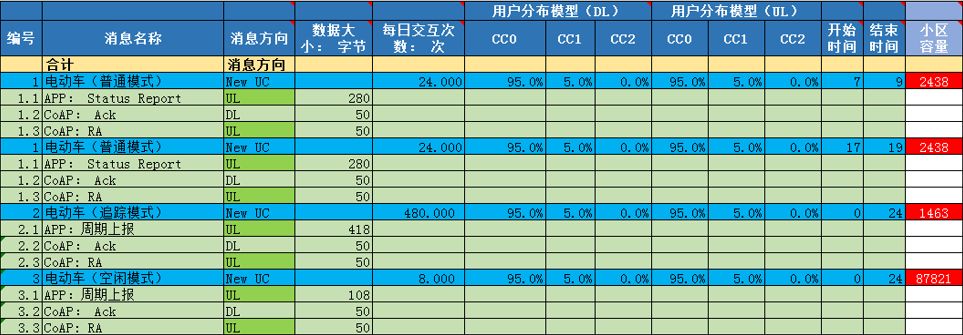 According to the cell capacity calculation, the pilot area has 183 cells, which can support: 2323*183=425109 users in normal mode, and 1463*183=267729 users in tracking mode. This meets the user demand in the pilot area.3Network Performance Improvement3.1 Tackling Network Performance IssuesIn the pilot area of Dengfeng, as the number of NB terminals increased, the success rate of RRC establishment in the NB-IoT network severely deteriorated. An emergency optimization team was established to analyze and address the electric vehicle access issues.
According to the cell capacity calculation, the pilot area has 183 cells, which can support: 2323*183=425109 users in normal mode, and 1463*183=267729 users in tracking mode. This meets the user demand in the pilot area.3Network Performance Improvement3.1 Tackling Network Performance IssuesIn the pilot area of Dengfeng, as the number of NB terminals increased, the success rate of RRC establishment in the NB-IoT network severely deteriorated. An emergency optimization team was established to analyze and address the electric vehicle access issues.
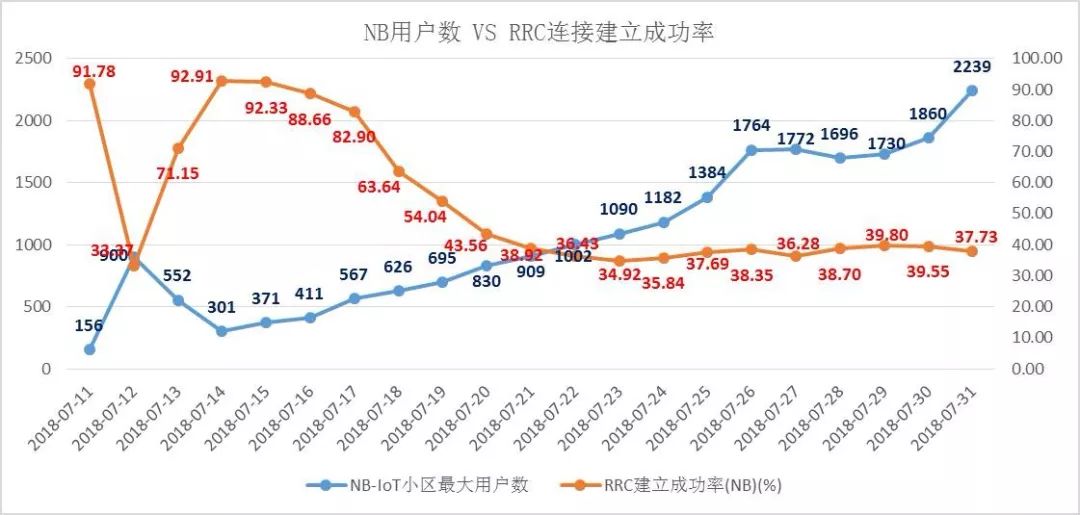
3.2 Analysis and Optimization Actions:
With the rapid increase in the number of NB terminals, the success rate of RRC connection establishment dropped from 91% to 37%. Through KPI monitoring and TOP cell analysis, the main reason for RRC failure was found to be UE no response, accounting for 99.997%; this was mainly concentrated in coverage level 2, accounting for 87.4%. The optimization team formulated measures for parameter optimization, TOP cell optimization, and RF optimization to improve the RRC establishment success rate.3.2.1 Baseline Parameter Consistency CheckThrough parameter verification, inconsistent parameters with the baseline were identified:
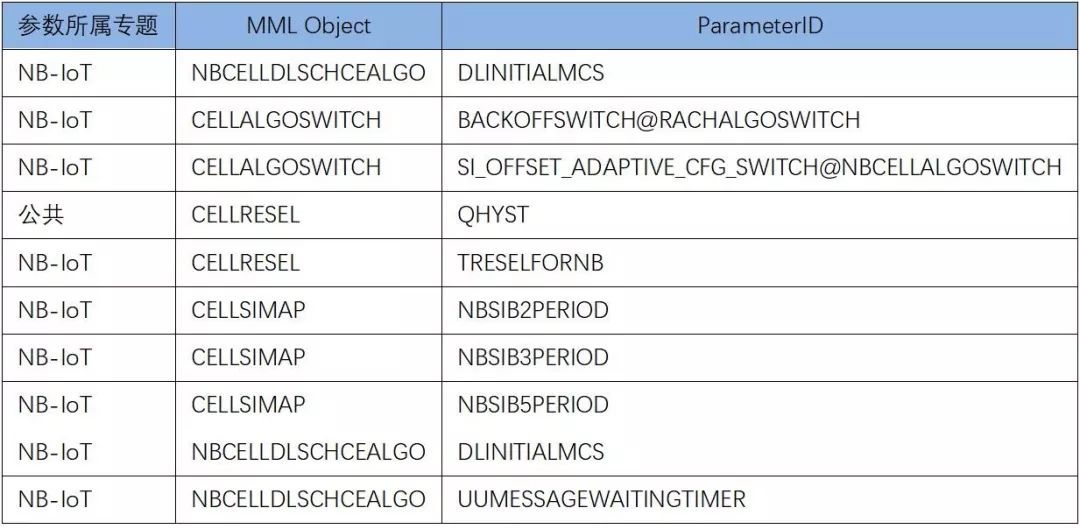
3.2.2 Up and Downlink Scheduling Algorithm Parameter and Some Timer OptimizationParameter Optimization Action One: Up and Downlink Scheduling Algorithm Parameter OptimizationObjective: The user ratio of coverage levels 1 and 2 is too high, leading to resource constraints, and the high repetition of coverage levels 1 and 2 also causes resource limitations. These parameters mainly reduce the repetition of coverage level 2, decreasing resource overhead.1. Optimization of PDCCH repetition times for coverage level 2:2. Optimization of downlink repetition times for coverage level 2:3. Optimization of MSG UCI repetition times for coverage level 2, and uplink repetition times, along with configuring logical channel timers.Parameter Optimization Action Two: Related Timer Optimization1. Optimization of three coverage level conflict resolution timers;2. Optimization of T300 parameters;3.2.3 Up and Downlink Scheduling Algorithm Uplink Access User Scheduling Optimization SwitchWhen the switch is turned on, the scheduling priority of UE access signaling can be enhanced to improve overall network access performance (RRC establishment success rate, average RRC establishment delay, etc.).3.2.4 Extended Access Prohibition Algorithm SwitchThe EABAlgoSwitch switch is on, and the base station dynamically issues or cancels the system message SIB14 based on the current load of the cell, with SIB14 carrying extended access prohibition parameters to control the access types applicable to EAB UE.3.2.5 TOP Cell Parameter OptimizationParameter Optimization Action One: Coverage Level AdjustmentTOP cells are selected based on high RRC connection establishment request counts and high subcarrier resource utilization for coverage levels 1 or 2.Parameter Adjustment: Disable coverage level 2 or 1, allowing users to access in coverage levels 1 or 0.Parameter Optimization Action Two: Uplink Power Control Parameter OptimizationTOP cells are selected based on poor RACH access success rates as RRC connection counts or user numbers increase, and severe uplink noise issues.Parameter Adjustment:① PreambInitRcvTargetPwr (initial target power value for preamble reception): Increasing this value appropriately increases the probability of successful access with one preamble transmission, but increases interference to neighboring cells.② P0NominalPUSCH (nominal P0 value for PUSCH): Increasing the P0 value appropriately increases terminal transmission power, improving the signal received by the base station and enhancing baseband demodulation capability.3.2.6 External Interference Troubleshooting and Frequency ClearingAs the golden spectrum of the 2G era, 900MHz has been widely deployed globally, with many types of repeaters and interference sources. After the NB stations were opened, many stations experienced uplink interference, which could lead to uplink desynchronization and packet loss, significantly impacting network performance. The project team established multiple interference troubleshooting groups to focus on the affected cells.Frequency scanning revealed interference sources, mainly from privately installed signal amplifiers, power grid room signal amplifiers, and interference from base stations of different systems. A detailed clearing plan was developed, coordinating various departments to eliminate interference sources.
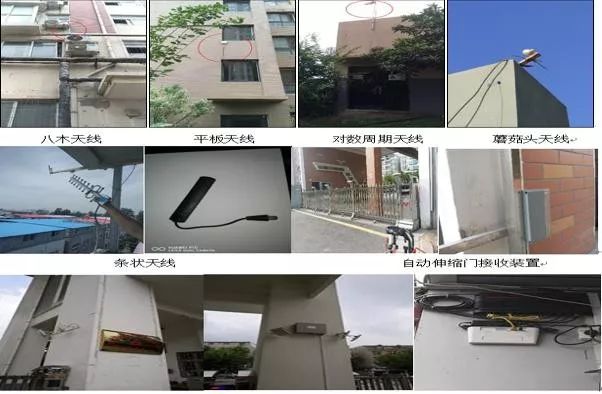
Case Study: Building 12 of Beihuan Xihu Garden – Signal Amplifier Interference
The uplink RSSI of base stations 1 and 2 in Building 12 of Beihuan Xihu Garden were -83.6dBm and -91.52dBm, respectively, with severe uplink interference. On-site interference troubleshooting was conducted, and an interference source was found 50 meters south of the base station.
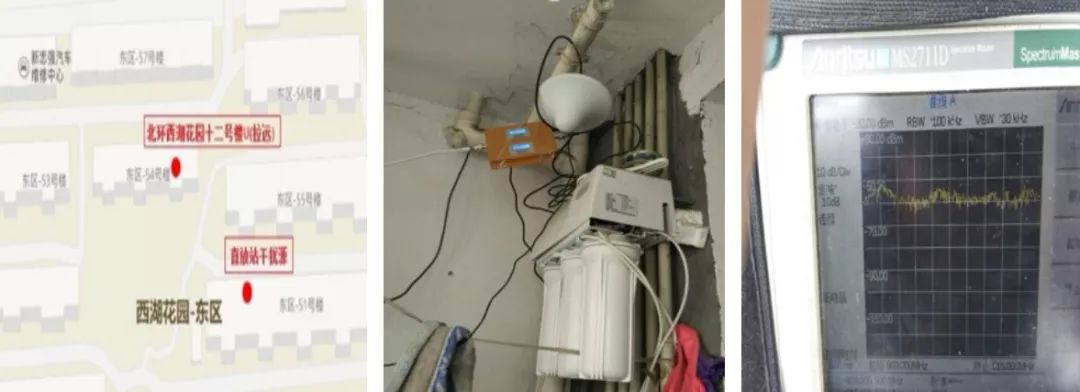
After coordinating to shut down the amplifier, the interference disappeared, and the RSSI value recovered to around -128dBm.
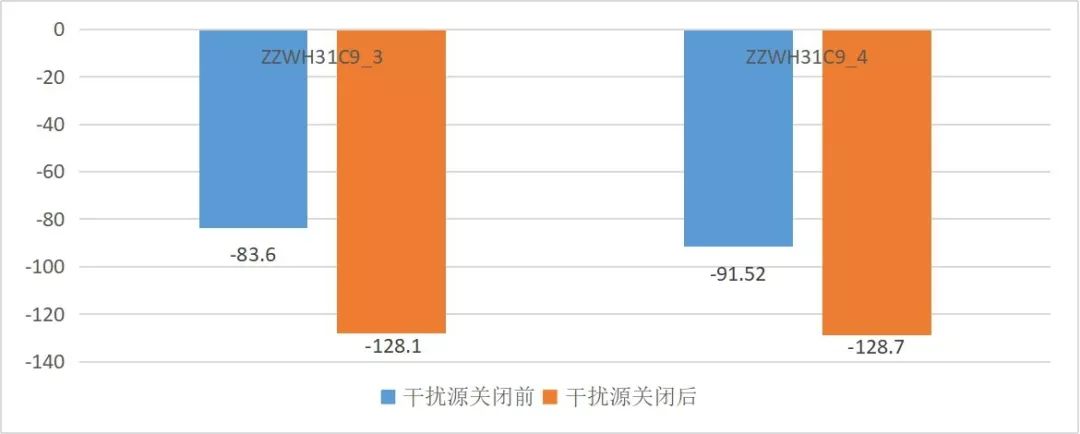
3.3 Performance Improvement ResultsThe special optimization team conducted in-depth optimization of the RRC establishment parameters for the NB-IoT network in Dengfeng City, reducing RRC retransmission counts and lowering air interface resource occupancy. The RRC connection establishment success rate improved from 35.93% to 96.46%, showing significant results, with normal electric vehicle access and good user experience.
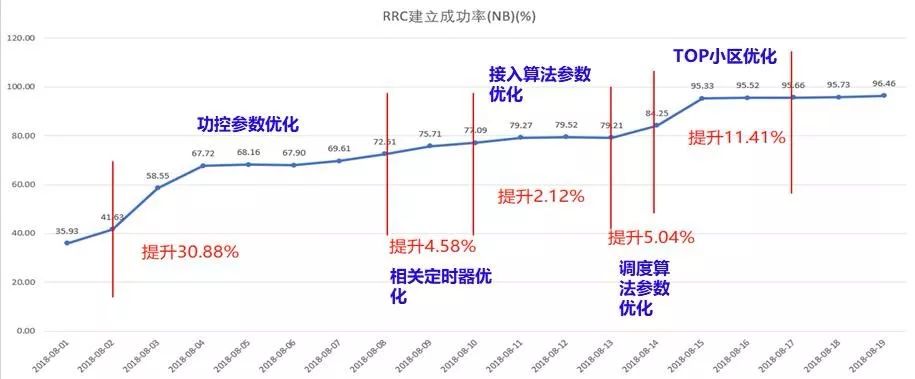
4Terminal and Network Compatibility OptimizationBased on previous NB experiments, optimization plans were developed to address compatibility issues with modules, chips, and network strategies.Network Parameter Optimization:1. The network side should adjust strategies such as base station reselection thresholds and module online timers based on business application needs to achieve timely reselection after module disconnection and increase the number of available modules.Terminal and Protocol Optimization:1. For IoT applications with frequent uploads, optimize the module terminal protocol to use UDP to avoid transport layer protocols, preventing issues caused by excessive handshakes and confirmations leading to retransmissions and prolonged resource occupation.2. Upgrade terminal versions to resolve issues where terminals cannot control power and always transmit at maximum power, leading to increased network noise and affecting access success rates.Module Mechanism Optimization:1. Optimize the reconnection mechanism of modules based on business applications. Currently, modules attempt to reattach after detecting disconnection at intervals of 5s, 30s, 1min, 2min, and 5min, and if no network is found, they search again after 2 hours. This design considers that most NB scenarios require low power consumption. For electric vehicle applications, timeliness is more critical than power consumption, so consider modifying the reconnection interval at the chip level.2. For IoT applications with high concurrency, implementing a staggered reporting mechanism for terminals is crucial; otherwise, network capacity will struggle to meet business demands. The staggered mechanism for NB terminal network access processes will be implemented in the 3GPP R14 protocol.Chip Performance Optimization:Currently, the mixed networking of NB1800M and NB900M requires optimization of IoT chip performance to support dual-band and adaptive frequency, addressing terminal reselection and data transmission issues in different frequency bands.5ConclusionDue to its characteristics of “high connectivity, high coverage, low cost, and low power consumption” and insensitivity to delay, NB-IoT networks are particularly suitable for applications in wireless meter reading, sensor tracking, and other fields. The municipal electric vehicle comprehensive management project is the first large-scale IoT innovative application project in Henan and even nationwide. By establishing an integrated network support working group, conducting preliminary support estimates, outputting plans, and driving problem resolution; issues such as terminal and network incompatibility, external interference, and parameter settings were identified and resolved, ensuring good results. Successfully assisted the public security bureau in completing user access in the pilot area, electric vehicle theft prevention, and comprehensive traffic management, earning a good reputation for the Unicom company in the IoT market.
▎References:
[1] Stefania Sesia et al. LTE/LTE-Advanced – Theory and Practice of UMTS Long-Term Evolution. People’s Posts and Telecommunications Press, 2012.
[2] Wu Xigang. From Principles to Practice of NB-IoT. Electronic Industry Press, 2017-09.
[3] Xie Yunzhao. Detailed Explanation of NB-IoT Technology and Industry Applications. Science Press, 2017-05-01.
[4] Dai Bo, Yuan Yifei, Yu Yuanfang. Narrowband Internet of Things (NB-IoT) Standards and Key Technologies. People’s Posts and Telecommunications Press, 2016-11.
▎Author Information:
Zhu Yan, Intermediate Engineer, Master’s Degree, mainly engaged in mobile network optimization and maintenance work, currently serving as the manager of the network optimization center;Li Jing, Intermediate Engineer, Master’s Degree, mainly engaged in mobile network optimization work;Zhao Wentao, Intermediate Engineer, Bachelor’s Degree, mainly engaged in mobile network optimization work.

